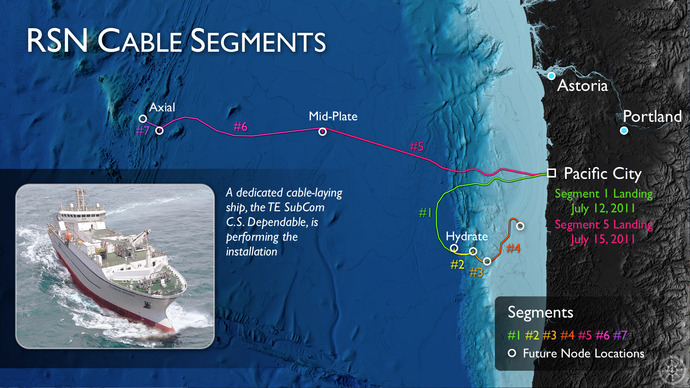- Visions18
- Visions17
- Visions16
- Visions15
- Visions14
-
Construction
- Node Installations Complete!
- Six on the Seafloor!
- New Segment 7
- Defining the SIA
- PN5A Successfully Deployed!
- PN 5A – Jointing Operations
- PN 5A Installation Continues
- On Site to Install PN5A
- Transit to Node 5A
- Port Call in Portland
- PN1D is Installed!
- Burial and Inspection Completed ...
- Humpbacks Visit
- Cable Burial Node PN1C
- Milestone: PN1C is Installed
- Photos of Final Inspection of P ...
- Another RSN Node is Born!
- Cable Burial Continues at Secon ...
- Second Node Installed!
- Splicing Node PN1B into Segment ...
- Recovering End of Segment 3
- Word for the Day: Persistence
- Major Milestone: First Node Ins ...
- Primary Node 1A Powered Up on D ...
- Recovering and Testing Cable Se ...
- OOI Primary Node Installation B ...
- Cable Installation Update
- Dolphins and Puffins and Molas, ...
- Day 51: Seabed Cable Lay Comple ...
- Dynamic Positioning
- Update on Cable Installation
- Completion of Segment 1 Burial
- Leaps and Bounds at the Shore S ...
- Segment 5 Installation Complete ...
- Laying Segment 5
- Bustling Shore Station
- At-Sea Installation Phases
- Installing the Land Cable
- TE SubCom Dependable Propulsion ...
- Divers at Work
- The Day After
- Second OOI Cable Landed
- Second Cable Landing Reschedule ...
- OOI Open House in Pacific City, ...
- The Cable has Landed!
- Last Grapnel Run Before Landing ...
- Preparing for the Cable Landing ...
- Seaplow 101
- Marine Mammal Observations
- Communicating with a Fishing Ve ...
- Cable Deployment Update
- Off Pacific City, Oregon
- Finished with First Segment
- Deploying Repeaters
- Start of First Cable Segment
- Leaving Astoria
- Meeting the Cable Ship in Astor ...
- Cable Laying Vessel Underway
- Photos of OOI Cable Loading
- Northern conduit installed
- Northern Conduit drilling compl ...
- Bubble test for the Southern Co ...
- Drilling of the Northern Condui ...
- Update on Drilling
July 2013
May 2013
December 2012
October 2012
August 2012
July 2012
April 2012
March 2012
January 2012
October 2011
September 2011
August 2011
July 2011
June 2011
March 2011
February 2011
October 2010
June 2010
May 2010
April 2010
- Visions13
- Visions12
- Visions11
- Enlighten
The plow and ROV have given us a bit of extra work over the past two to three days. The unfortunate combination of a few bad elements resulted in the "chewing" of almost 2km of cable by our sea plow, just 10km from the end of plow work (burial location) along Segment 5.
Then, as we headed close to shore, hoping to make up for lost time and support diver burial operations, our ROV decided to break down. It was nothing that our crew could not fix though! A few days later we are back in business and making progress again! By early morning, on July 22nd, we had completed the cable repair and were getting ready to launch the plow again to install the end of Segment 5 after a successful test of the cable. (Cable testing is done to identify and locate any optical or electrical faults that may occur during installation. The goal is to verify the integrity of the cable conductor and the continuity of the fibers (especially at spliced or fused locations). The tests are designed so that the vessel can operate independently from shoreside support as much as possible. Electrical integrity is periodically monitored with a megohmmeter throughout installation.)
Moving forward at 0.5 knots, we obtained good burial depth ( greater than 1.3m on average) on a nice soft seabed. As for all OOI cable segments installed on the Oregon continental margin, our end of burial (EOB) location has been agreed upon with the Oregon Fishermen's Cable Committee (OFCC) and corresponds to a position exactly 1km seaward of the 700-fathom Essential Fish Habitat (EFH) boundary. This boundary essentially defines the seaward extent of bottom-trawling activities. Therefore, the risk of entanglement with trawl fishing gear is much reduced past this boundary. There are other risks, of course, including a rougher and more unstable seabed down the continental slope, where rocks and sediment slides are more likely to occur and where cable abrasion is a greater threat. But we have planned accordingly for cable armor.
By 8pm on July 22, burial operations on Segment 5 were completed and another great milestone for the project had been achieved! While the plow headed slowly back to the surface, the vessel made its way toward deeper waters.
Today (23rd of July) we have been in surface-laying mode, laying our cable gently on the seabed down the lower part of the continental slope and across the heavily sedimented seafloor of the Cascadia basin. Segment 5 will end at the location of the MidPlate node. We are now "cruising" at 5 knots, the fastest speed we have reached in a long time, and are slowing only for the passage of a splice box or a repeater. The laying will continue through the night, and we should reach the end of this segment by morning.
--Cecile Durand, OOI Maintenance Operations Manager, University of Washington, onboard the TESubCom Dependable


